JACKSONVILLE, Fla. – The 2020 Hurricane season begins on June 1st, and four aspects of how the National Hurricane Center provides forecasts will change this year.
Storm Surge Forecast Graphic
Recommended Videos
This season, the NHC will begin providing an experimental graphic in 2020 that will depict the expected storm surge inundation values for the United States Gulf and Atlantic coasts, Puerto Rico, and the U.S. Virgin Islands that are provided in the tropical cyclone public advisory (TCP). These values represent the peak height the water could reach above normally dry ground somewhere within the specified areas. This graphic will be made available on the NHC webpage.
Below is an example of what the graphic will look like.
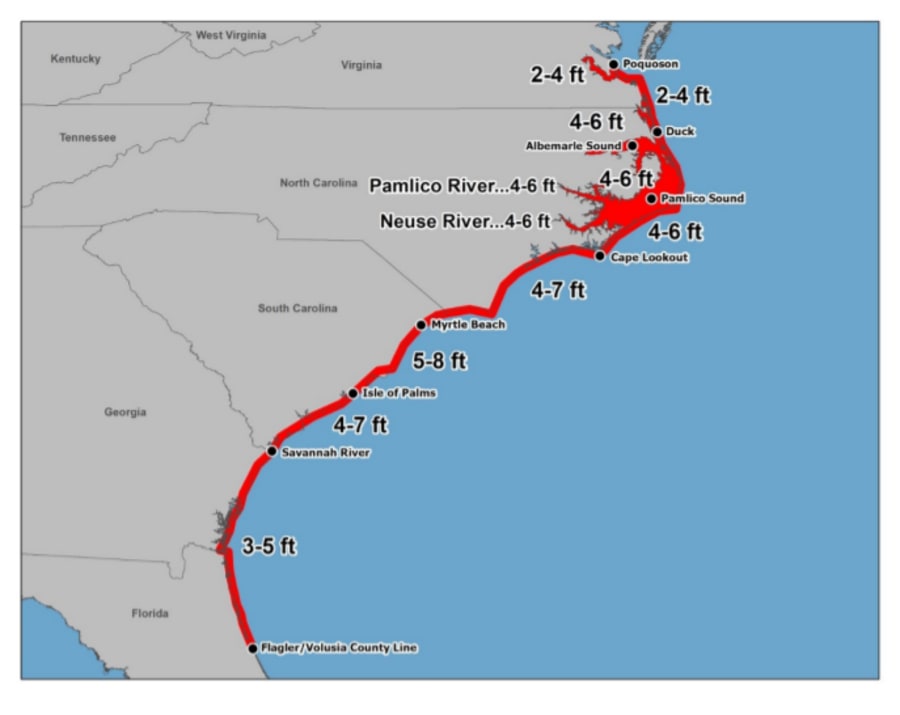
60 Hour Forecast
Also new this season, the NHC will begin providing 60-hour track, intensity, and 34-kt and 50-kt wind radii forecasts. These forecasts will be included in the tropical cyclone forecast/advisory (TCM), tropical cyclone discussion (TCD), and referenced within the tropical cyclone public advisory (TCP). The 60-h forecast information will also be included on the NHC cone graphic and will be used in the computation of the NHC wind speed probabilities, time of arrival graphic and probabilistic storm surge products.
This means we will see an extra forecast point in the forecast cone for hurricanes, in between the 48 hours and 72 hour forecast points on the cone, there will be an additional forecast point for the 60 hours out forecast. This will be most helpful for us when forecast cones are showing turns or curves, the additional point may provide a more accurate representation of where and when the storm will curve.
Below is what the new 60 hour forecast point will look like in the forecast cone:
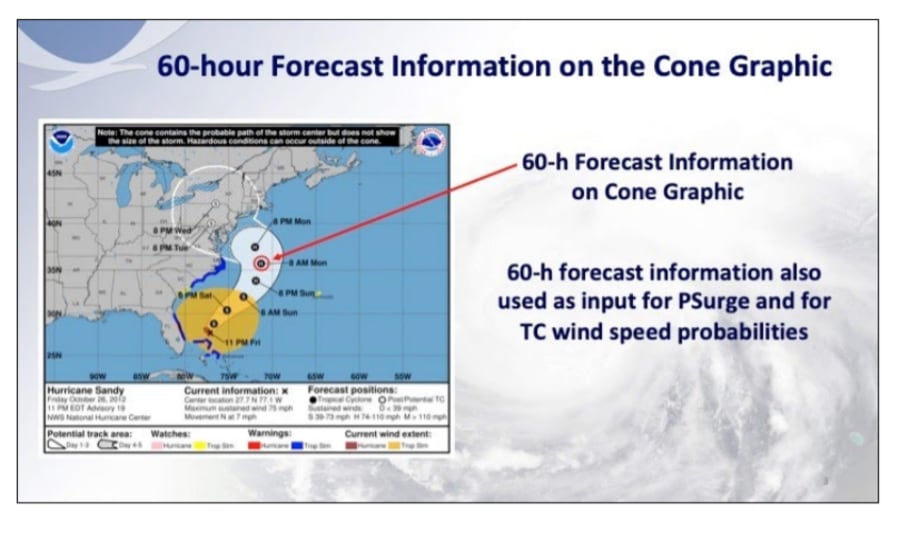
And here is how the 60 hour forecast point information will be included in text forecast information from the NHC:
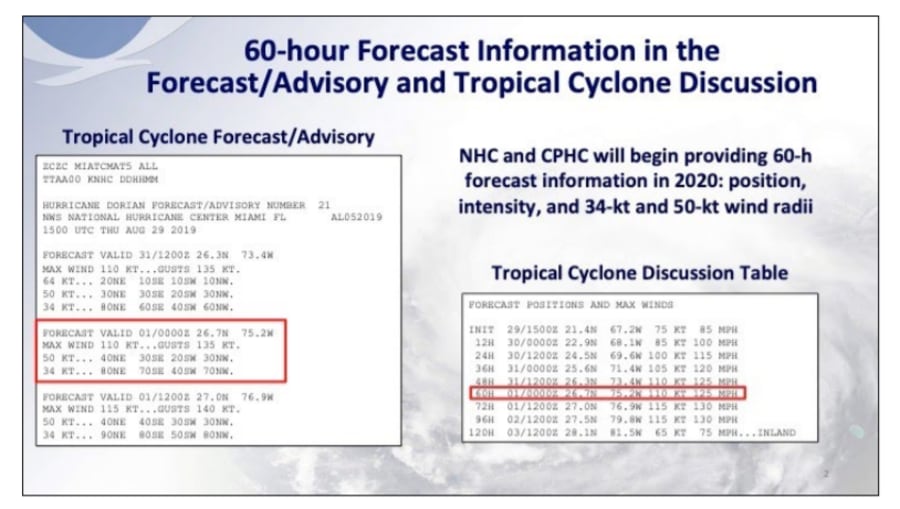
Using local time zones for systems in the Eastern Atlantic
The NHC public advisories, tropical cyclone discussions, tropical cyclone updates, and some graphical products have used local time within the product header based on the time zone where the center of the tropical cyclone is currently located. For example, advisories for tropical cyclones centered in the central and western Gulf of Mexico have used Central Time, and those near the east coast of the United States or in the eastern Gulf have used Eastern Time. All other Atlantic basin tropical cyclone advisories have referenced Atlantic Standard Time. This however, can be problematic for systems affecting the Cabo Verde Islands or other locations in the northeastern Atlantic basin where locations are 3 to 4 hours ahead of Eastern Time. Beginning in 2020, systems located south of 25°N and east of 30°W will use Cape Verde Standard Time (GMT-1) and systems north of 25°N and east of 45°W will use Greenwich Mean Time (equivalent to Azores Summer Time). These times will be used for the public advisory (TCP), discussion (TCD), update (TCU), and all graphical products that use local time.
The actual issuance times of these products remain the same with full advisory packages issued at 0300, 0900, 1500, and 2100 UTC (5 am, 11 am, 5 pm, and 11 pm EDT). Intermediate public advisories are issued at 0000, 0600, 1200, and 1800 UTC (2 am, 8 am, 2 pm, and 8 pm EDT) whenever coastal tropical cyclone watches or warnings are in effect.
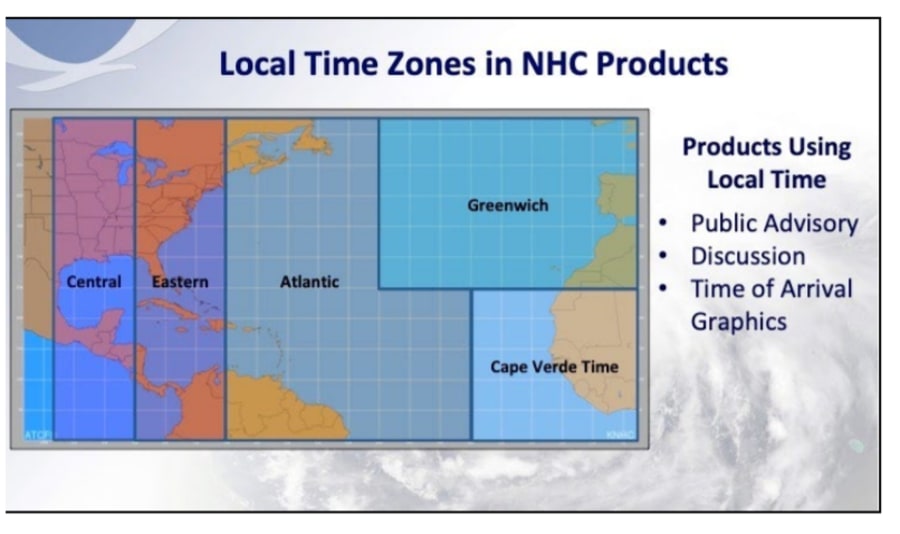
Annual update to the track forecast error cone
The size of the tropical cyclone track forecast error cone for the Atlantic basin will be mostly unchanged this year. The eastern Pacific basin cone graphic will be slightly larger from 36 to 72 h, and slightly smaller at 120 h. The cone represents the probable track of the center of a tropical cyclone, and is formed by enclosing the area swept out by a set of imaginary circles placed along the forecast track (at 12, 24, 36 hours, etc.). The size of each circle is set so that two-thirds of historical official forecast errors over the previous five years (2015-2019) fall within the circle. The circle radii defining the cones in 2020 for the Atlantic and eastern North Pacific basins are given in the table below:
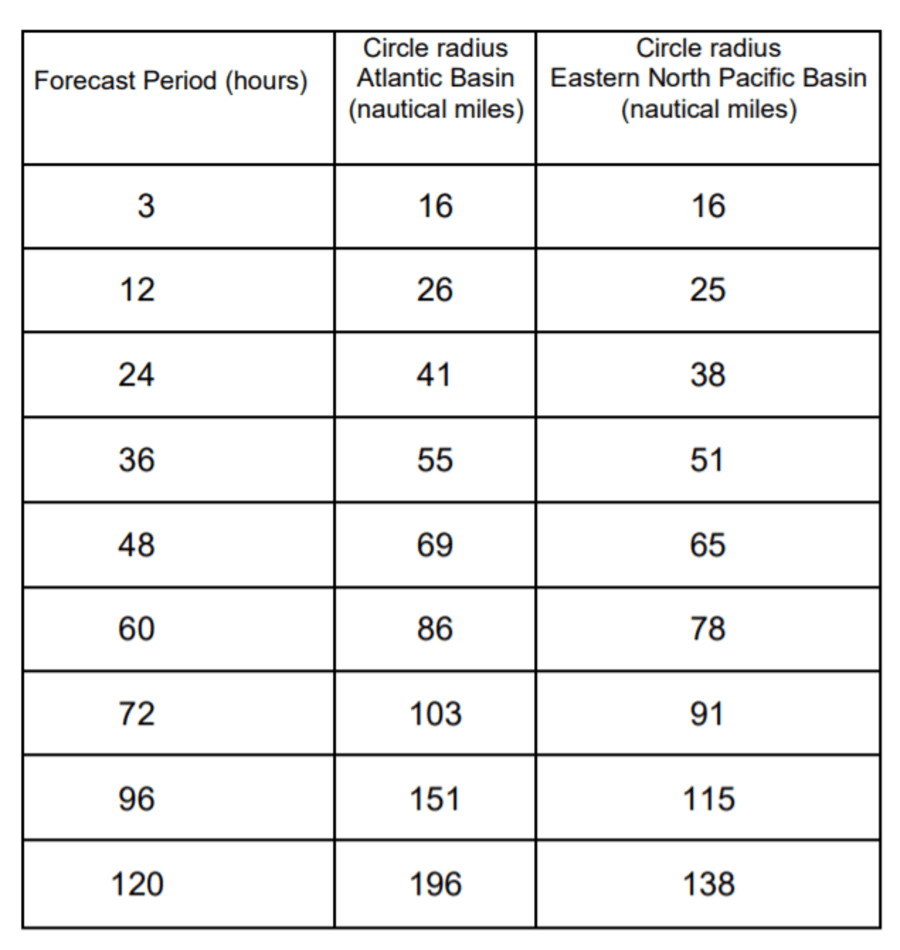
Below is a video explaining how you should interpret and use hurricane forecast tracks.
Other items of interest for 2020
1) Pronunciation guides for storm names including the phonetic pronunciations of all Atlantic and eastern North Pacific storm names can be found on the NHC website at:
Atlantic: www.nhc.noaa.gov/pdf/aboutnames_pronounce_atlc.pdf
Eastern North Pacific: www.nhc.noaa.gov/pdf/aboutnames_pronounce_epac.pdf
Note that the World Meteorological Organization’s Region IV Hurricane Committee was unable to conduct its annual meeting in 2020. As a result, the business of updating the region’s operational plan, which includes storm name retirement for 2019, was not conducted. Any consideration of a 2019 storm name retirement will be completed at the 2021 meeting, as the 2019 names will not be used again until 2025.
2) The National Hurricane Center has a Facebook page. The NOAA NWS National Hurricane Center page provides updates about the NHC outreach and education campaign and other items that might be of interest to the public throughout the year. During the hurricane season, the site contains a daily tropical weather update for both the Atlantic and eastern North Pacific basins, as well as alerts regarding any tropical cyclone activity as needed. The NHC also conducts Facebook Live briefings during tropical cyclone events.
3) The National Hurricane Center is on Twitter – and has five twitter accounts:
- Interactive Outreach (@NWSNHC) - The broadest in scope of NHC’s Twitter accounts
- @NWSNHC is our primary mechanism for engaging the public and our partners in twoway conversations. This account will cover general topics such as education and outreach, NWS products and policies concerning tropical cyclones, significant events, or just fun facts – from across all of the branches that comprise NHC. There are two operational Twitter feeds, one for the Atlantic basin -
- @NHC_Atlantic (which includes the Gulf of Mexico and Caribbean Sea) and one for the eastern North Pacific basin -
- @NHC_Pacific. Automated tweets are sent via these accounts whenever NHC issues: • A public advisory regarding a tropical cyclone (TCP) • A tropical cyclone update (TCU) Each tweet contains a link to access the corresponding product on the NHC website. These two operational accounts will also be used to supplement and augment the formal tropical cyclone product suite, with occasional notices on such topics as reconnaissance aircraft status, announcements on NHC’s intention to initiate advisories on a new tropical cyclone, highlights of key messages during active cyclones, etc.
- The NHC storm surge group can be followed on Twitter at @NHC_Surge This account enhances storm surge forecasts by providing real-time reports and observations during an event (resources permitting). The feed will enhance preparedness and outreach efforts throughout the year, and provide news and announcements on updates to the SLOSH modeling system and storm surge decision support tools.
- The Tropical Analysis and Forecast Branch (TAFB) is on Twitter at @NHC_TAFB TAFB, an operational arm of the NHC, is responsible for issuing more than 100 marine products daily covering millions of square miles of the Atlantic and eastern Pacific Ocean. This account highlights significant weather events over the marine area as well as its outreach programs.
4) An audio podcast will be available when the media pool is activated. The audio podcast RSS/XML feed for top-of-the-hour briefings will be operational when the media pool is activated: www.nhc.noaa.gov/audio. The media pool is typically activated when a hurricane watch is issued for any portion of the U.S. contiguous coastline.
5) On the Web: National Hurricane Center: www.hurricanes.gov
Graphical Tropical Weather Outlook: www.nhc.noaa.gov/aboutnhcgraphics.shtml#GTWO
Definition of NHC Track Forecast Cone: www.nhc.noaa.gov/aboutcone.shtml www.nhc.noaa.gov/cone_usage.php
National Hurricane Preparedness Week: www.hurricanes.gov/prepare
National Hurricane Center Facebook page: www.facebook.com/NWSNHC
National Hurricane Center Twitter page: www.nhc.noaa.gov/twitter.shtml




